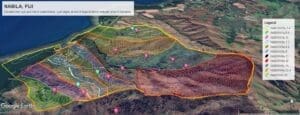
Under current policies and practices, the process of restoring the health of soils and the Global Hydrological Cycle (both are critical to plant growth, and the very survival of plants and animals (including Homo sapiens!), is going to take a very long time – decades, if not generations. One way of accelerating the process might be to put in place policies that involve community action that focus on the protection and restoration of those natural resources that fall within community related watersheds and sub-watersheds. Everybody (both urban and rural) in the community needs to be involved. Everybody, no matter how large or small, should contribute to restoration efforts, whether be it for improving soil health on a farm or garden, or reducing waste and pollutants in urban areas. For rural areas there are many measures and technical solutions that can and should be applied, but for restoring soil health and water, Vetiver Grass Technology (VGT) provides a well-tested, low cost, and easy to use mitigation tool that can be adopted by communities. See “Stiff Grass Hedgerows (Barriers) and Contour Cultivation are Key to Watershed Improvements”.
We need to find a process that allows VGT to be applied at scale and at landscape/watershed level, particularly on land used for agricultural purposes. A presentation, Embedding Vetiver Grass Technology Into Farm Systems At Various Scales Under “Tropical” And “Semi-Arid” Conditions describes the benefits, and how it can be undertaken at farm scale. The issue is how to apply it at scale for a landscape.
Two initiatives (referred to later in this Newsletter) are being undertaken by island nations in the Caribbean and South Pacific that may provide a basis for community upscaling. Both involve TVNI Board Directors, Jonathan Barcant (Trinidad and Tobago) and Robinson Vanoh (Papua New Guinea). As background both have small companies providing vetiver services, and both are commited to supporting community action relating to soil and water.
In the Caribbean, VEEP (The Vetiver Education & Empowerment Project) model, introduced to six Caribbean countries, has the learning objective of: an in-depth understanding about VGT and VS, leading to wider community awareness of VS benefits; a hands-on experience and capability in vetiver plant propagation, preparation, and installation according to VS best practices; and the identification of basic requirements for VS “green” business development within a community. This approach is community oriented involving potential users and community leaders at all levels.
In the South Pacific, Robinson Vanoh has been training communities in Fiji (a Fijian Government, Ministry of Waterways and Environment Initiative – see training manual). The most recent VGT training of the 8 villages is an initiative by Pacific Community-SPC through funding support from Pacific Adaption to Climate Change and Resilience (PACRES). All eight villages had old vetiver plantings from the 1950s, mostly forgotten and not maintained, not understood, and their benefits not recognized by most of the current community members. Most of these communities are linked to relatable small watersheds (500-1,000 ha). It should not be difficult to extend community training to practical watershed planning with VGT as the “prime mover”. Why VGT? Because of its multiple applications and benefits for various sectors interested in mitigating soil and water problems; and VGT provides a very good topic for discussion and “gossip”, even though its application might sometimes be replaced by an alternative. Community members, including the least educated, can talk about it, feel it, and see it; and once they know its wide range of capability, they can and will use it.
Both initiatives put emphasis on developing vetiver nurseries that can supply vetiver planting material, and the use of well trained and experienced trainers.
Very small farms often share a sub-watershed; larger farms however have multiple watersheds of various size within their boundary – so planning needs differ between farms. The key VGT applications for both large and small should focus on contour hedgerows for erosion control and rainfall run off reduction, stream bank buffers, drainage line and farm pond/dam protection, farm roads/tracks protection (and safe water disposal from these), restoration of point source erosion problems (land slips, gullies, degraded slopes), and treatment of domestic and farm waste-water and contaminated leachates. Any of the forgoing actions are within the capability of most farmers, whatever the size, if given the knowledge and adequate access to a supply of low cost vetiver grass planting material and some initial advice.
One approach might be to break a community watershed down into sub watersheds and micro watersheds; identify the owner/cultivator(s) with rights to the “watershed/catchment” area; and the encourage all occupants of the area to undertake agreed actions over a period of time (years) – in effect, neighbors planning and working together for the good of each other.
Community planning needs useful mapping tools. Much can be done using Google Earth with contour overlays. More on this can be found at this link and at the following:
How to use Google Earth Pro to support the planning and monitoring of farm, watershed, and landscape improvements in relation to vetiver grass technology.
How to create a contour line overlay layer for Google Earth Pro.
Back in Time – 35 years ago – John Greenfield revisits Fiji 1986, and a Farmers’ Day Field in India (1987)
John Greenfield was the instrumental person responsible for creating the current interest and use of the Vetiver System by leading a an initiative in the introduction of the technology to some World Bank funded Watershed programs in India. Before doing this he went to Fiji to revisit vetiver hedgerow plantings that he introduced to farmers in the mid 1950s. He made this video (40 minutes) that I recovered from some boxes just recently! It has many interesting features – part is in Hindi – the farmer explaining the benefits of vetiver hedgerows, the natural terraces formed, no soil or nutrient losses, ease and minimum cost of application .
I also came across this 17 minute video of a farmers’ field day held at Gundalpet, Karnataka held in 1987. It was an important event, since the participants included the Union Secretary of Agriculture and four state Secretaries, as well as John Greenfield and I. We were there to see and learn first-hand from farmers whose families had used vetiver for generations (100 years or more) for soil and water conservation. I believe the opening statement to the video is made by the then Secy. of Agriculture for Karnataka.
Another video from a different visit to a watershed program at Kaba Nala, Karnataka where vetiver was used as “keylines” for both protection and as a guide for contour cultivation. That year, 1987, had seen a serious Monsoon season drought that severely affected the Monsoon (kharif) crop. Farmers practicing contour cultivation had better crop survival and yields than those that didn’t. Listen to John Greenfield discussing these and other aspects of soil management. Many farmers today still do not farm on the contour, by not doing so they are losing precious rainwater. Contour cultivation is a near zero cost process with large benefits!
Vetiver Network national coordinators appointed for Ecuador and Mexico

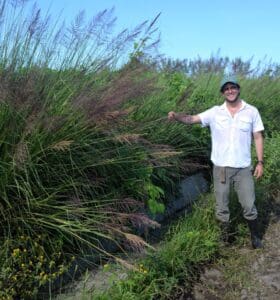
As recently announced by Rafael Luque, Coordinator of the Latin American Vetiver Network, Antonio Carrillo Bolea, from Mexico, and Piet Sabbe, from Ecuador, have stepped forward and volunteered to be the National Vetiver Coordinators for their respective countries. More details here.
Congratulations to them both. Anyone interested should contact them.
Youth4Climate Call for Solutions
Strategy Reloaded, a social enterprise, based in the Caribbean island of Saint Lucia, that is driving vetiver technology and

innovation forward to address some of the most prominent issues facing communities and countries, received a UN “Youth4Climate “award of US$20,000 award in the Food and Agriculture category for its Vetiver Smart Farm Transformation. Alongside 25 other innovators, David Henry, TVNI Member from the West Indies and CEO of “Strategy Reloaded”, relayed the potential of vetiver and its unique features as a green engineering tool—a reliable solution to addressing issues of soil and water. Vetiver’s impact on the future of food security was emphasized, not only in Saint Lucia and the Caribbean but also globally. Congratulations David Henry!
Kenya Vetiver initiatives.
This year has seen a lot of activity in Kenya with focus on Regenerative Agriculture.
Sustainable Village Resources
A charity with partnership comprising Caleb Omolo and Christian Makokha established a program for women farmers at Lela (Siaya County – near Lake Victoria) with the following objectives: (a) train and supporting 35 women to adopt regenerative farming using vetiver grass as the main catalyst as opposed to their current mono-culture practices; (b) reversing the decline in soil fertility and health caused by many years of mono-culture framing of maize; (c) establishing a demonstration food forest to

train local community and other institutions; and (d) developing a 0.25 ha vetiver nursery.
To date, the training has been completed; a forest garden has been developed, comprising vetiver hedgerows and seven layers of food forest layers and related companion plants; a kitchen garden integrating vetiver grass with different indigenous vegetables that mature at different stages that provide farmers vegetables and other products all year round; and a vetiver nursery inter-cropped with maize and beans has been established.

This program has become of great interest to community leaders, and one of them, Odda Howard, founder of Africa Widows and Orphans Foundation, has agreed to support the continuation of the program. She has established 1.75 ha vetiver nursery to supply vetiver slips to more farmers in her community and Siaya county, and will provide facilities for future training. A full report of the project activities can be found here.
The US based “Trees For the Future” (TFF)
with agro-forestry programs in western Kenya, has decided to include vetiver into its regenerative practices and is establishing vetiver nurseries. Peter Kingori has been a leader in bringing vetiver to TFF farmers one of whom, Dani Odari, has rehabilitated a flooded dumping ground into a thriving small farm in the Homa Bay area.
Kenya’s Kiambu County
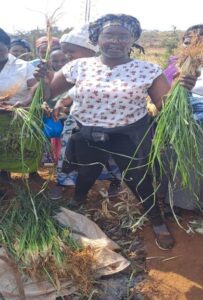
A central Kenya county frequently effected by drought and badly eroded. TFF is working with farmers to use regenerative agricultural practices. One of its trainers, Nancy Wambui, wrote “In the semi-arid lower parts of Central Kenya, farmers are waking up to a new-found hope for their erosion-prone soils — vetiver grass. We are creating vetiver nurseries. We first prepared the land by tractor disc plough. For maximum productivity, we spaced the rows at 50cm and slips at 20cm intervals. We sourced the slips from a demo farm within Kiambu County. These come in large clumps that we split into manageable sizes for replanting. These healthy, well grown slips assure quick rooting and vigorous growth. For ease of maximising on water usage, we have also established a small unit where we use polytubes. Unlike the direct bare-root nursery, vetiver polytubes management is seamless and hassle free.
We have designed the demo site to incorporate agro-ecological interventions (eg. cover crops, nitrogen fixers, soil organic matter) where we will intercrop with vetiver.
Many people have not heard about this wonder grass (vetiver). We have embarked on educational forums to mobilize and create awareness, with a special emphasis on women’s groups which are the backbone of rural agriculture in our area. In these fora, we introduce vetiver and teach about it’s many advantages. We conclude this exercise by practical demonstration on land preparation and vetiver planting.”
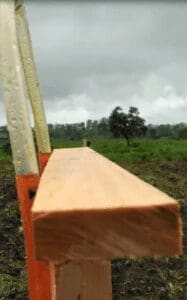
Northern Kenya – A Vetiver initiative by a farmers group.
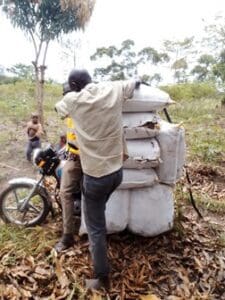
Surrounding Mt. Marsabit there are some 20,000 ha of land that receives sufficient rainfall to crop. The area can suffer from drought and has severe storms that result in flash floods and erosion. Most of the farmers are livestock owners. Climate change is just adding to landowners’ problems. Recently Somo Abdukadir, a local farmer/businessman got to know about vetiver from Christian Makokha (Lela project). He investigated in depth, and concluded that vetiver might solve many of their problems. He and another 15 farmers got together as a group. Somo has set up a 1 acre vetiver nursery on his farm, some of his initial plant material was gifted by Paul Kombo, Caleb Omolo, and Christian Makokha. His first field day attracted over 100 farmers and local government officials, and farmers went home with a few plants. Somo has already been checking on these farmers to make sure that vetiver slips are properly cared for. We are hoping that Somo Nursery will become the center for vetiver promotion and training in the area. He is hoping to eventually employ a “technician” to survey contour marker lines for vetiver hedgerows using the Mark 2 sighting level – see sight level construction guide.
Philippines – Mt. Apo – Cultivation and intensive farming on very steep slopes.

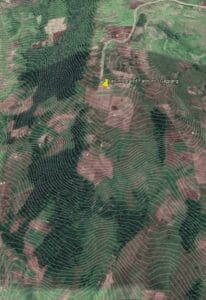
Climate change and unrestricted farm development on the upper slopes of Philippines’ highest volcano has resulted in major downstream flooding and property damage and serious erosion in the upper watersheds of the main rivers. Allan Amps a local businessman and landowner (with property at both ends of the watershed) knows and feels the problem, and is determined to do something about it. He has a vetiver nursery; has good contacts with farmers and local government; and takes the trouble to research the problem and potential mitigating actions and technologies. Allan is particularly interested in the Miral River catchment area and associated flood mitigation. He realizes the importance of demonstration and has found a partner in the Lao Integrated Farms — https://www.laointegratedfarms.com/welcome — a long established organic farm business, that has recently acquired land located high in the watershed. The Lao family propose show casing VGT contour-farming, vermicast production using VG biomass, mycorrhizal fungi, and endophytic microbes liquid fertilizer & inoculant, etc. The farm will be used as a demonstration and training center for other farmers. Allan Amps has many skills, and is a quick learner! I am hoping that he will develop new ideas for planning and monitoring the scale up of vetiver on a watershed basis. He is already creating and using our guideline for Google Earth with contour layers. See his presentation on “Miral River – Flood Disaster Mitigation. a watershed basis”.
South Pacific Islands – Relearning how to use (and observe) Vetiver Grass Technology and its benefits.
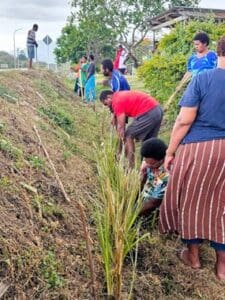
Robinson Vanoh, TVNI Board Director and Managing Director of Eagle Vetiver System Inc, has been working with vetiver for 17 years (see this presentation for a history of vetiver in Papua New Guinea) and has been instrumental in reviving and expanding its adoption in a number of South Pacific Islands. He is involved in ongoing projects in Papua New Guinea, Solomon Islands and Fiji. Although living in Lae, Papua New Guinea, his “home” village is at Goroka (Eastern Province) where he is leading a vetiver initiative for his community, starting off with converting a rather and barren Kiss Hill (30% slope) into a food forest. He writes “Empowering Communities: Nine villages in Fiji are now Vetiver System (VS) champions! These include the villages of Nadolodolo, Nadelei, Vanuakula, Rabulu, Korovou, Tavualevu, Nabuna (Tavua), Semo and Nabila village in Nadroga. Thrilled to announce the game-changing training sessions that equip these communities against flooding and soil erosion. The magic lies in sustainable, low-cost biotechnologies featuring the incredible vetiver grass! As part of the PACRES project’s Community of Practice program, we’re customizing resilience efforts and livelihood training to boost community capacity. From on-farm to off-farm, our sessions covered VS applications, techniques, and the awesome benefits it brings. Let’s grow together, sustainably!” I think that it is very important when training individuals and communities that vetiver’s wide range of applications are discussed, as well as the add on benefits from using vetiver, whatever the particular application. Some studies show that vetiver users in rural areas place vetiver benefits such as mulch, pest control, farm boundary hedges, and thatch at a higher level than soil erosion control. This is particularly so where the land user has no legal ownership of the land.
Vetiver activities in the Caribbean continue to expand at a community level.
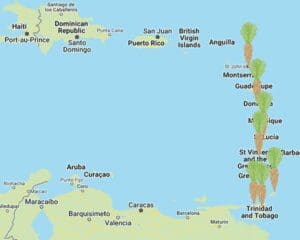
I recommend that you find time to visit The Vetiver Network West Indies (TVNWI) website at https://tvnwi.org/ “Vetiver grass can be used to assist with a wide range of soil, water and environmental challenges, and can also be used in many other ways for social and human benefits. These are listed in sections of the website highlighting uses of vetiver grass and The Vetiver System (VS), and range from slope stabilization and erosion control, to the production of essential oils and handicrafts.
“The Caribbean small island states in particular stand to gain much from having a basic level of common public knowledge about vetiver grass and the Vetiver System (VS), as it can be easily and quickly used at a low cost to protect roads, homes, infrastructure, steep and hilly agricultural lands, and coastlines. This is especially important for rural and far-off communities who can be easily disconnected through landslides and road collapse. Members of these communities who adopt knowledge and use of vetiver grass to protect their properties can also supplement their livelihoods through the production of useful handicraft products with vetiver leaves and fragrant roots, such as baskets, mats, soaps and chairs, and can also install hedgerows to treat and mitigate contaminated rainfall runoff from entering marine environments they often depend on.
TVNWI with its integrated links to Trinidad and Tobago’s IAMovement and Vetiver TT provides a source of Vetiver System information relating to associated training initiatives and development programs. Development strategy uses VEEP (Vetiver Education and Empowerment Project) model as an Ecosystem-based Adaptation (EbA) approach to take knowledge, education and training to communities about vetiver grass and the Vetiver System (VS), as a low-cost green infrastructure tool to solve a wide range of soil and water related challenges across Antigua & Barbuda, Dominica, Saint Lucia and Trinidad & Tobago. This is currently being done with through “Grassroots4LaVie!” — Strengthening Coastal and Marine Climate Resilience through Upland and Coastal Ecosystem Based Adaptation and Community Engagement. Grassroots4LaVie! is being supported by a number of funders including Caribbean Biodiversity Fund, IICA, IAMovement, EbA, and University of Florida“.
The VEEP model can be modified to adjust to particular project and partner scenarios and needs, but in principle entails the following elements which have been found to be most important for its overall success. The Vetiver Education & Empowerment Project (VEEP) model includes:
- Identification of key project implementing partner(s)/ individual(s).
- Selection of project participants.
- Establishment of vetiver nurseries.
- Carrying out technical project training modules (classroom and field).
- Project site selections and carrying out of for Vetiver System (VS-EbA) interventions.
- Carrying out vetiver handicraft making and developing training.
- Co-creation of educational material with the local project leads/NGO (e.g. project brochure).
- Production of short educational videos and/or high-quality documentary film.
- Green business development and livelihood opportunities.
Learn more about the VEEP model here and here.Under the “Grassroots4LaVie” program some short documentaries have been made, each relating to an Island program:Antigua and Barbuda – Background Video Dominica – Background Video
Grenada – Background ..Video St Lucia – Background Video St Vincent and the Grenadines – Background Video Trinidad and Tobago — Background Video
Indian activities – what next? Is a strategy being developed for scaling up VGT?
![]()
![]() Following ICV7, well attended by participants from India, efforts are being made to develop a new and vigorous vetiver initiative that will embrace all aspects of the Vetiver System. Agriculture World (India’s largest agriculture news outlet and magazine) set up
Following ICV7, well attended by participants from India, efforts are being made to develop a new and vigorous vetiver initiative that will embrace all aspects of the Vetiver System. Agriculture World (India’s largest agriculture news outlet and magazine) set up ![]() the “AW” vetiver forum on WhatsApp, where some wide-ranging views, experiences, and vetiver applications have been shared and discussed. There will be a “Conclave” in Coimbatore in February 2024 to plan for future activities and institutional/administrative arrangements. India is a huge country.It will be interesting to see what strategy is devised to promote VGT at scale. There are over 600,000 villages in India. I think that the February 2024 Conclave will have to think “outside of the box” and look for new approaches for VGT promotion and application. I am certain that government policy, some sort of mass distribution of information, and VEEP type education and empowerment programs will be necessary. I recall when working in China that a lot of farm information is distributed through mass publication and distribution of technical manuals. Today the internet and smart phones (most Indian villages have electricity) replace the need for some of the hard copy- these instruments of communication will need practical and easy to follow vetiver content.
the “AW” vetiver forum on WhatsApp, where some wide-ranging views, experiences, and vetiver applications have been shared and discussed. There will be a “Conclave” in Coimbatore in February 2024 to plan for future activities and institutional/administrative arrangements. India is a huge country.It will be interesting to see what strategy is devised to promote VGT at scale. There are over 600,000 villages in India. I think that the February 2024 Conclave will have to think “outside of the box” and look for new approaches for VGT promotion and application. I am certain that government policy, some sort of mass distribution of information, and VEEP type education and empowerment programs will be necessary. I recall when working in China that a lot of farm information is distributed through mass publication and distribution of technical manuals. Today the internet and smart phones (most Indian villages have electricity) replace the need for some of the hard copy- these instruments of communication will need practical and easy to follow vetiver content.
From the social networks –
How to shred vetiver for the prospective use as mushroom substrate or as an animal feed base for additives (urea and molasses)
Shredding Vetiver for mushroom substrate (video)
Kenya: VGT for land restoration, conservation and regenerative agriculture. (video)
Regenerative agriculture with Vetiver/ (video)
Dominican Republic (Spanish audio) – Food Forest (video)
Research of interest.
Substitution of plant residues of medicinal importance for production of oyster mushroom:
Vetiver may not (based on this experiment) be the best mushroom substrate but it is pretty close, and in some areas where other substrate resources are not available it would be the best, particularly if home grown with no chemicals.
Vetiver grass is a potential candidate for phytoremediation of iron ore mine spoil dumps.
This research confirms the potential , because of its high tolerance to iron, for the restoration of iron mine dumps. “A pilot study was conducted to investigate its potential to rehabilitate iron ore spoil dumpsites generated from the Joda East Iron mine located in Odisha, India. Four diverse genotypes of vetiver: S2 (diploid variety), S4 (tetraploid derivative of S2), TH (originated from Thailand), BL (a broad leaf) were grown over a period of 12 months to observe their growth performance, metal tolerance and metal uptake. Based on the results it can be inferred that vetiver grass per se can tolerate high concentrations of Fe along with other heavy metals in its tissues. Such potential vary across the four genotypes, and the genotype BL (from Thailand) followed by S4 (a triploid) can be claimed of paramount importance in terms of phytoremediation”.
Research to think about. … Bananas
In recent weeks I have been corresponding with Allan Amps (Mt. Apo, the Philippines) as to what applications vetiver might be used for on banana farms (there are some large ones of more than 200ha). Often these farms are high on the slopes of Mountain Apo, and contribute to concentrated watershed run off, sediment, and probably excess fertilizer and other chemicals. Clearly vetiver could be used for stabilizing farm roads and drains (saving the owners significant annual maintenance costs), as well as reducing erosion sediment flows, improving vertical drainage, and taking up excess farm chemicals. The question is could it be planted as contour hedgerows with resulting in improved crop yield, lower costs and improved net benefits.
One of TVNI’s directors, Criss Juliard, introduced vetiver to banana growers in Senegal. Here follows an exchange of emails (circa 2006) between him and Doug Richardson (California):
Hello Doug,
Vetiver is used to surround banana plantations along the coast in Morocco as a wind break; in Senegal, we worked on an erosion protection trial in a banana plantation by planting ½ ha of banana’s with vetiver hedgerows following the contour; and next to it, ½ ha without vetiver; both were on a slight 3º slope. Surprisingly, we found the banana trees produced ripe bunches about 4-6 weeks earlier in the vetiver plot than the no-vetiver plot. We concluded non-scientifically the vetiver hedgerows allowed for great moisture retention and a steadier availability of moisture to the plant; strategic conditions for better growth and yield. Neither plots had drip irrigation, which is a factor to be reckoned, but both received the same amount of gravity-fed watering.
In another experience in Senegal (it was non-scientific because it was by chance), a plant pathologist friend planted some vetiver plants that I had given him, near some of his banana trees. He was surprised to see the banana trees’ growth and development near the vetiver superior to those further away from vetiver (even though he did not water the vetiver). He dug a small trench around one of the banana trees to look at the banana roots and found its root system decidedly turned towards the vetiver, concluding a symbiotic relation developed between the two plants, and that perhaps vetiver roots were better at dosing water than his banana watering regime.
One of the biggest problems we had early on with banana growers in Senegal was there preference to flood irrigation over drip. Slowly, large and small plantations converted to drip (measured and timed), and Senegal now exports bananas while before they were net importers; part of that shift was due to the persistent civil disruptions in neighboring Ivory Coast that could no longer supply the Senegalese banana market.
I hope your expanded banana plantation is highly successful. Try placing vetiver on some parts and not in others. We have been planting bananas here in Morocco adopting a technique we found in Lebanon; a square meter hole, and a banana plant at each corner with one irrigation outlet at each hole. Planting the banana plant 50 cm below surface level eliminated nematode problems, and with one simple tie around the four grown trees we eliminate individual “tutors” and the risk anything touching the bananas.
All the best,
Criss Juliard
Dear Criss , Thanks so much for,your information about Vetiver and bananas . I delayed responding to you in the hope I would be able to obtain some photo images of a banana/vetiver planting that I did here in California in 1999 . I will get them and send them to you , but for now I will say that bananas and vetiver do work very well together here also . However, vetiver’s beneficial influence was not limited to bananas alone . Along with the bananas I planted dozens of other subtropical fruit trees which are considered as marginal specialty crops in our area . Almost without exception their growth exceeded our expectations. I agree with you that vetiver greatly improves the moisture regime for the plants in it’s vicinity but i suspect that an equally powerful factor is the microbiological activity in the rhizosphere of the vetiver and it’s attendant impact on the nutritional status and vigor of nearby plants . Vetiver’s potential as a nurse crop has been touted in the literature and my experience supports that perspective . The windbreak aspect that you mentioned is also a strong contributing factor to strong rapid development of plants growing with Vetiver . Here in California I have tried both drip irrigation and microjets with bananas. Both produced acceptable results . Some of the literature suggests that drip is preferable to sprays in the subtropics because it doesn’t wet and cool the bananas pseudostems in our heat deficient environment . However , the sprays provide more humidity . I need more time with a new planting to discern. I look forward to discussing this more with you . Thanks , Doug“
From Criss to me “I must confess that I am surprised by the results, particularly with fruit trees. In one banana plantation, vetiver was planted along half a hectare, and next to it another half hectare without vetiver. The results are staggering. Good production on the first plot with no run off, NO production yet and less leaf on the next, and deep riling. As this was established on a plantation owned by a member of a banana producer’s association, the entire association has now adopted the use of vetiver hedging between alternating rows. The stimulus is the demand for nurseries to produce the plant.”
Following up on microbiology aspects in the rhizosphere I came across these two interlinked research papers that show (1) the beneficial endophytic bacterium in vetiver can reduce the incidence of soil born Fusarium wilt in bananas. I would also suspect that vetiver will improve vertical drainage and will help aerate the soils. Additionally vetiver could be used as mulch, improve soil health, reduce soil temperatures, and provide habitat for beneficial insects that might further improve the health and productivity of the bananas with less use of chemicals.
Draft Genome Sequence of Burkholderia cenocepacia Strain 869T2, a Plant-Beneficial Endophytic Bacterium
In planta biocontrol of soilborne Fusarium wilt of banana through a plant endophytic bacterium, Burkholderia cenocepacia 869T2
I would suggest that the banana industry on Mt Apo take a good look as to whether vetiver can help solve some of its problems. A few exploratory practical trials would be very easy to carry out. Twenty years ago grape producers were very suspicious of using vetiver, but some are now using vetiver with surprisingly good results – more on this in another newsletter.
Past Newsletters
November 2023 June/July 2023 May 2023 April 2023 March 2023 February 2023 January 2023 December 2022 November 2022 October 2022 September 2022 August 2022 July 2022 archived 1990-2002
Bonjour, et merci pour cet article vraiment très complet, il y a tellement de chose à dire sur les racines de vétiver. Cette plante de mérite qu’à être connue davantage.
Je souhaite plein de succès et de progrès continus à tous les projets en cours.
Atouma,
Hello, and thank you for this very comprehensive article. There is so much to say about vetiver roots. This plant deserves to be more widely known. I wish all the ongoing projects continued success and progress.
Atouma, reader from France
RIchard GRIMSHAW
Thank you, and I agree with you!